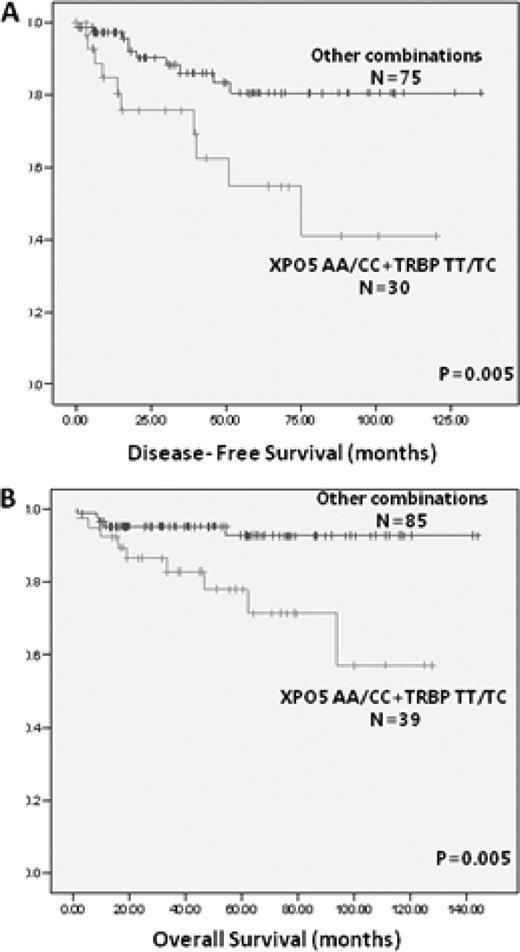Abstract
Abstract 1561
In recent years, the microRNA (miRNA) pathway has emerged as a crucial regulation system in tumorogenesis. miRNA expression is deregulated in the tumor, and miRNAs can function both as oncogenes and tumor suppressor genes. miR-SNPs are a novel class of single nucleotide polymorphisms that can affect miRNA biogenesis and target sites and can alter the expression and functions of miRNAs. We have evaluated 9 miR-SNPs and investigated whether a distinct haplotype of miR-SNPs predicts clinical outcome in HL.
One hundred and forty-one adult patients (median age, 32 yrs; range, 13–89; males 51.1%) diagnosed with HL in our institution between September 1995 and June 2005 were included in the study. Distribution according to histology: nodular sclerosis (58.9%), mixed cellularity (17.7%), lymphocyte rich (6.4%), lymphoid depletion (4.3%), and nodular lymphocyte predominant (7.1%). Epstein-Barr Virus was present in 38.1% of the samples. SNP analysis was performed by allelic discrimination on ABI Prism 7500 (TaqMan assays) in DNA obtained from formalin-fixed, paraffin-embedded lymph nodes. We examined 9 miR-SNPs: 4 in miRNA genes (MIR196A2 rs11614913; MIR149 rs2292832; MIR423 rs6505162; MIR146 rs2910164); 2 in miRNA binding sites (KRT81 rs3660; FAM179B rs1053667); and 3 in miRNA-processing machinery (XPO5 rs11077; RAN rs14035; TRBPrs784567). miR-SNP genotypes were correlated with probability of treatment failure, treatment-related toxicity, disease-free survival (DFS) and overall survival (OS).
The median follow-up was 50 months (range, 1–143). Of 141 patients, 119 (84.4%) achieved complete response, 7 (5%) showed a partial response, and 14 (9.9%) were chemoresistant. We observed an increased probability of treatment failure in patients carrying the XPO5 AA or CC genotype (P=0.036). In 14 patients with neurological toxicity, an association was observed with the KRT81 genotype (P=0.047). In 7 patients with bleomicine-associated pulmonary toxicity, we observed an association with the XPO5 genotype (P=0.048). XPO5 and TRBP genotypes emerged as significant markers for DFS. Mean DFS for 57 patients (56%) with the XPO5 AC genotype was 111 months vs 82 months for patients with the AA or CC genotype (P=0.044). Mean DFS for 37 patients (31.6%) with the TRBP CC genotype was 124 months vs 90 months for patients with the TT or TC genotype (P=0.022). A trend towards an association between the MIR196A2 genotype and DFS was also observed (P=0.07). Only the XPO5 genotype was associated with OS. Mean OS for 66 patients (54%) with the XPO5 AC genotype was 134 months vs 111 months for patients with the AA or CC genotype (P=0.038).
Given the evidence for the influence of TRBP and XPO5 as individual markers, we then investigated the combined effect of these miR-SNPs on DFS and OS. We found a significant correlation between the TRBP/XPO5 haplotype and DFS (P=0.005) and OS (P=0.005). Patients with the XPO5 AA/CC and TRBP TT/TC genotypes had the worst prognosis (DFS: 71 vs 114 months; OS: 95 vs 135 months).
In the multivariate analyses, the TRBP/XPO5 haplotype (OR, 2.977; 95%CI, 1.1–7.4; P=0.01) emerged as an independent variable for DFS. Only the Hasenclever prognostic index (OR, 5.7; 95%CI, 2–18; P=0.004) emerged as an independent variable for OS, but we observed a trend towards significance for the TRBP/XPO5 haplotype as well (P=0.06). In conclusion, miR-SNPs are a novel class of SNPs that can add useful prognostic information on the clinical outcome of HL, specifically in the detection of chemoresistant patients and patients likely to relapse. The TRBP/XPO5 haplotype has surfaced as a promising prognostic factor that warrants further investigation to confirm its role as a biomarker in HL.
Kaplan-Meier curves for DFS (A) and OS (B) according to the TRBP/XPO5 haplotype.
No relevant conflicts of interest to declare.
Author notes
Asterisk with author names denotes non-ASH members.


This feature is available to Subscribers Only
Sign In or Create an Account Close Modal